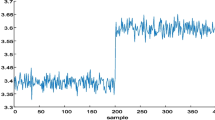Abstract
The auto-associative kernel regression (AAKR) and Gaussian process regression (GPR) have been used for estimating the condition of the sensors in the on-line monitoring system of the nuclear power plants. The estimations of the condition could be biased by the data of an unhealthy sensor, even though GPR generates its predictive uncertainty as a part of the predictions which AAKR may not provide. An effective modification to GPR, which enables early detection of the unhealthy sensor based on the prediction uncertainty and the residuals of estimations, is proposed to eliminate the influences of the biases. The proposed method which is named as an enhanced GPR (EGPR) shows a better performance in estimating the states of the sensors than that of AAKR and GPR with the test data from the flow system.
Similar content being viewed by others
Change history
10 June 2019
There is one correction to make to the original article. Fig. 4 was published incorrectly. Fig. 4 has to be corrected as follows:
References
A. Christopher, M. Andrew and S. Stefan, Locally weighted learning, Artificial Intelligence Review, 11 (1997) 11–73.
E. A. Nadaraya, On estimating regression, Theory of Probability & Its Applications, 9 (1) (1964) 141–142.
G. S. Watson, Smooth regression analysis, Sankhyā: The Indian Journal of Statistics, Series A (1964) 359–372.
M. P. Wand and M. C. Jones, Kernel Smoothing, Chapman and Hall/CRC (1994).
J. W. Hines, D. Garvey, R. Seibert and A. Usynin, Technical review of on-line monitoring techniques for performance assessment, Theoretical Issues, The University of Tennessee-Knoxville, 2 (2008).
C. K. Williams and C. E. Rasmussen, Gaussian Processes for Machine Learning, MIT Press, 2 (3) (2006) 4.
F. Di Maio, P. Baraldi, E. Zio and R. Seraoui, Fault detection in nuclear power plants components by a combination of statistical methods, IEEE Transactions on Reliability, 62 (4) (2013) 833–845.
N. Sairam and S. Mandal, Thermocouple sensor fault detection using auto-associative Kernel regression and generalized likelihood ratio test, Computer, Electrical & Communication Engineering (ICCECE) International Conference on. IEEE (2016).
S. AI-Dahidi, P. Baraldi, F. Di Maio and E. Zio, Quantification of signal reconstruction uncertainty in fault detection systems, Second European Conference of the Prognostics and Health Management Society (2014).
M. Alamaniotis, A. Ikonomopoulos and L. H. Tsoukalas, Gaussian processes for failure prediction of slow degradation components in nuclear power plants, European Safety and Reliability Conference, Prague, Czech Republic (2010).
V. Vitelli and E. Zio, Approximate Gaussian process regression with sparse functional learning of inducing points for components condition monitoring, Chemical Engineering Transactions, 33 (2013) 907–912, Doi: https://doi.org/10.3333/CET1333152.
P. Baraldi, F. Mangili and E. Zio, A prognostics approach to nuclear component degradation modeling based on Gaussian process regression, Progress in Nuclear Energy, 78 (2015) 141–154.
R. Tipireddy, M. Lerchen and P. Ramuhalli, Virtual sensors for robust on-line monitoring (OLM) and diagnostics, ANS 10th International Topical Meeting on NPIC-HMIT (2017).
A. Nair and J. Coble, Bayesian inference for high confidence signal validation and sensor calibration assessment, ANS 10th International Topical Meeting on NPIC-HMIT (2017).
P. Ramuhalli, R. Tipireddy, M. Lerchen, B. Shumaker, J. Coble, A. Nair and S. Boring, Robust online monitoring for calibration assessment of transmitters and instrumentation, NPIC & HMIT 2017, Pacific Northwest National Lab.(PNNL), Richland, WA (United States) (2017).
P. Ramuhalli, G. Lin, S. L. Crawford, B. A. Konomi, J. B. Coble, B. Shumaker and H. Hashemian, Uncertainty quantification techniques for sensor calibration monitoring in nuclear power plants, No. PNNL-22847 Rev. 1, Pacific Northwest National Laboratory (PNNL), Richland, WA (US) (2014).
R. N. Neal, Priors for infinite networks, Technical Report No. CRG-TR-94-1, University of Toronto (1994).
R. N. Neal, Bayesian learning for neural networks, Ph.D. Thesis, University of Toronto (1994).
C. K. Williams, Computing with infinite networks, Advances in Neural Information Processing Systems (1997) 295–301.
J. Lee, Y. Bahri, R. Novak, S. S. Schoenholz, J. Pennington and J. Sohl-Dickstein, Deep neural networks as Gaussian processes, Arxiv Preprint Arxiv: 1711.00165 (2017).
Author information
Authors and Affiliations
Corresponding author
Additional information
Recommended by Associate Editor Byeng Dong Youn
Sungyeop Lee is a researcher in M&D Corporation. He obtained the B.S. degrees in physics and mathematics from Seoul National University in 2012. He is a Ph.D. candidate in theoretical physics at Seoul National University.
Jangbom Chai is a Professor in the Department of Mechanical Engineering at Ajou University. He obtained the B.S. and M.S. degrees in mechanical engineering from Seoul National University in 1984 and 1986, respectively. He studied machine diagnostics in the Acoustics/ Vibration Laboratory at MIT and obtained his Ph.D. degree in mechanical engineering from MIT in 1993. He received the O. Hugo Schuck Best Award from American Automatic Control Council and awards from the Korean Nuclear Society and Korean Society of Pressure Vessel and Piping.
Rights and permissions
About this article
Cite this article
Lee, S., Chai, J. An enhanced prediction model for the on-line monitoring of the sensors using the Gaussian process regression. J Mech Sci Technol 33, 2249–2257 (2019). https://doi.org/10.1007/s12206-019-0426-7
Received:
Revised:
Accepted:
Published:
Issue Date:
DOI: https://doi.org/10.1007/s12206-019-0426-7




